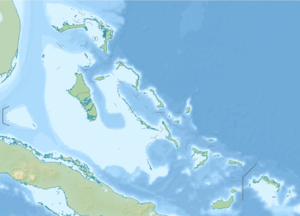Cat Island (Bahamas)
| Cat Island | ||
|---|---|---|
 | ||
| Gewässer | Atlantischer Ozean | |
| Inselgruppe | Bahamas | |
| Geographische Lage | 24° 27′ N, 75° 30′ W | |
| Länge | 76,8 km | |
| Breite | 21,9 km | |
| Fläche | 389 km² | |
| Höchste Erhebung | Mount Alvernia 63 m | |
| Einwohner | 1503 (2010) 3,9 Einw./km² | |
| Hauptort | Arthur’s Town | |
 | ||
Cat Island ist eine Insel und ein Distrikt der Bahamas. Hier befindet sich der höchste Punkt des Inselstaates, der 63 m hohe Mount Alvernia, auf dessen Gipfel das Kloster The Hermitage steht. Der Erbauer dieser Einsiedelei war John Hawes, besser bekannt als Fr. Jerome, ein englischer Franziskaner. Bevor er sich nach Cat Island zurückzog, wirkte er in Western Australia als Ordensmann.
Die ersten europäischen Siedler waren Loyalisten, die vor dem Amerikanischen Unabhängigkeitskrieg flohen und die Insel 1783 erreichten. Die Insel ist möglicherweise nach Arthur Catt, einem Piraten, benannt oder sie trägt ihren Namen auf Grund der einmalig großen Population an verwilderten Katzen.
Früher machten die Baumwollplantagen den Wohlstand der Insel aus, doch heute bildet Brandrodung für die Insulaner die Hauptlebensart. Wirtschaftlich rentabel ist auch die Ernte der Kaskarilla-Rinde. Sie wird gesammelt und dann nach Italien verschifft, wo sie ein Hauptbestandteil von Arzneimitteln, Duftstoffen und Campari ist.
Die Einwohnerzahl beträgt etwa 1500 und die Hauptsiedlungen sind Arthur’s Town (Sidney Poitier wuchs hier auf), Orange Creek und Port Howe.
Man glaubte lange Zeit, dass Cat Island die Insel Guanahani sei, auf der Christoph Kolumbus das erste Mal einen Fuß in die Neue Welt setzte, bis man widerlegende Dokumente fand.
Siehe auch
- Liste von Inseln der Bahamas
Weblinks
Auf dieser Seite verwendete Medien
Like most other islands in the Bahamas, Cat Island is located on a large depositional platform that is composed mainly of carbonate sediments and surrounding reefs. The approximately 77 kilometre-long island is the part of the platform continuously exposed above water, which allows for soil development (brown to tan areas) and the growth of vegetation. Shallow water to the west-south-west (below the island in this view) appears bright blue, in contrast to the deeper ocean waters to the north, east, and south. In this astronaut photograph, the ocean surface near the south-eastern half of the island has a slight grey tinge due to sun-glint, or light reflecting off the water surface back towards the International Space Station. Small white cumulus clouds obscure some parts of the island.
Autor/Urheber: Shane.torgerson, Lizenz: CC BY 3.0
View from the top of Mount Alvernia, the highest point in the Bahamas.




